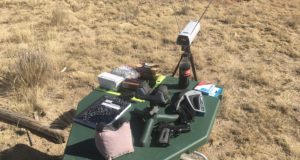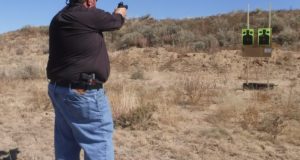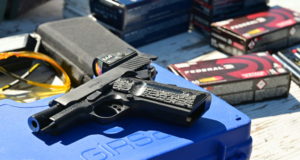Anyone who has ever sighted in a rifle at long range or spent a day at the range testing and tuning handloads knows how tedious it can be: Shoot… squint through the spotting scope… shoot… squint through the spotting scope… curse, re-acquire target through the spotting scope… struggle to remember which was the last bullet impact… sigh, wait for someone to call a cold range… trudge downrange, pull your target and post a new one… wait for someone to call hot range… shoot…
Now imagine how much easier it would be if this was all you had to do: Shoot. Press the space bar. Shoot again. Press the space bar again.
That’s the beauty of the Bullseye Target Camera system, an innovation that allows you to view your latest bullet impact on your laptop, at ranges up to 1000 yards and beyond.
The Bullseye system consists of a night-vision capable camera, antenna and wireless router, and in the case of the 1000-yard model, a signal booster. The whole thing runs off a lithium ion battery pack with a 5-hour life. The camera’s signal is beamed to your laptop, where the camera software runs from the provided USB drive. From there, the magic elves that live in your computer’s monitor scan for new bullet impacts, and scurry around marking them with brightly-colored Magic Markers.
Or, you know, something like that. I’m a little fuzzy on computer technology; I just know that it works. With every new shot, press the space bar on your laptop’s keyboard, and the last impact is there flashing on your screen.
Simply set up the camera on the tripod, aim it at the center of the target with the attached laser designator, and plug in your cables according to the laminated setup instructions. Everything else can stay in the padded carrying case.
Rifle, targets, ballistics calculator on the iPhone, netbook, and Bullseye Camera. Everything you need for a day at the range.
I had the opportunity to evaluate the Bullseye Camera System over a weekend’s shooting at Blogorado, and came away highly impressed. Initially we used the camera to monitor our 750-yard rifle target, and I was a bit disappointed with the performance. The software functioned perfectly, but the camera resolution left a great deal to be desired.
The fault, however, was my own. The system instructions recommend setting up the camera at 3-8 feet from the target, offset 45 degrees to get it out of the line of fire. However, with swirling downrange winds at 30 knots, and a number of shooters, including myself, with a tendency to be a little, well… ambitious, sometimes the misses are measured in feet, not inches. I didn’t want to hit a $500 camera with a stray .50 or .30 caliber round, so succumbing to an overabundance of caution, I set up the camera twenty feet away, and the resolution suffered.
However, our second range day was a different story. I set up the camera as directed by the manufacturer, both on our 200 yard and 100 yard targets, and the resolution was as bright and clear as looking at the target, well… three feet away.
Bullseye Camera on the 100 yard range.
No squinting through a spotting scope, fiddling with focus and dealing with the narrow field of view of a high magnification lens. No trudging downrange to pull and post targets. No posting new targets for new shooters.
I spent four hours and over 100 shots through various rifles, and only went downrange once to post new targets. As new shooters ambled over to try their hand, all that was necessary was to set up a new shooter profile on my laptop. A few keystrokes, and they were ready to start shooting on the targets already in place.
Camera in full viewing mode, showing all three targets.
The camera software allows you to set up unique profiles for each shooter, with options for different weapons and ammunition, and different colored shot markers for each shooter. The ammunition window allows you to input brand, caliber, bullet type and weight, notes and a variety of other data. Handloaders can set up a different ammo profile for everything they bring to the range, making the old-fashioned range notebook obsolete.
Tuning handloads? Set up a different profile for each load, all assigned to the same rifle.
What few quibbles I had with the system mainly stem from my writer’s sensibilities, and have nothing to do with the performance of the system. For instance, “bullet” is misspelled in the window for ammunition data. I’d like it if the shot markers were a bit smaller, closer to the diameter of the bullet holes themselves. None of these are gripes big enough to convince me not to buy this system.
"Define target" mode, used to zoom in on specific targets.
If you’re a reloader who spends a lot of time on the bench tuning different handloads, or a gunsmith who sights in a lot of rifles, I think you’ll find the Bullseye Target Camera system as indispensable a piece of equipment as your chronograph or boresighting tool. Even if you’re just an avid shooter, the system allows you to focus on the reason you came to the range: shooting.
The Bullseye Camera System is compatible with your Windows computer, with smartphone support coming soon. The 500-yard edition sells for a MSRP of $449, while the 1000-yard edition retails for $549. You can find them online here.
 Ambulance Driver Files A Day in the Life | Kelly Grayson
Ambulance Driver Files A Day in the Life | Kelly Grayson







